Amazongate may land Sunday Times in hot water
A claim published in the Sunday Times over the veracity of a statement published in an Intergovernmental Panel on Climate Change (IPCC) report may land the British newspaper in hot water.
On Sunday, Jonathan Leake, Science & Environment Editor of the Sunday Times, accused the IPCC of making a “bogus rainforest claim” when it cited a report warning that up to 40 percent of the Amazon could be “drastically” affected by climate change. Climate change skeptics immediately seized on “Amazongate” as further evidence to discredit the IPCC just two weeks after it was found to be using shoddy glacier data in its 2007 climate assessment.
Leake’s criticism was that the IPCC cited a report published in 2000 by WWF, an environmental lobby group, rather than a scientific study. He noted the report was authored by “two green activists” who presumably had an incentive to overstate the impacts of climate change on the planet’s biggest rainforest.
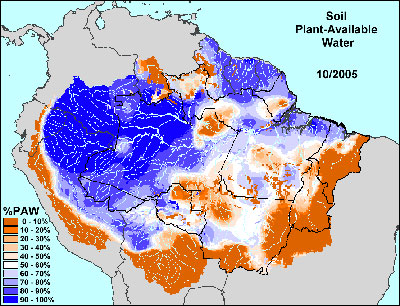 According to the WHRC, the above map is “a product of our ongoing drought monitoring effort from Oct. 2005, the worst month we have in our record going back to 1995. It shows moisture stored in the soil which is available for use by plants, what we call ‘Plant-Available Water’ or ‘PAW’, expressed as a percentage of the total water-holding capacity of the top 10m of soil at any given point; %PAW is one of the strongest indicators we have of severity of drought and of forest susceptibility to fire. Courtesy of WHRC. |
But Leake either overlooked or failed to comprehend the research upon which the WWF report is based. That data clearly supports both the WWF report and the IPCC report. Leake was actually warned of this oversight, before publishing his column, by the scientist who conducted the original drought research in the Amazon: Daniel Nepstad, now of the Woods Hole Research Institute.
Nepstad provided mongabay.com with a copy of the message he sent Leake after the Sunday Times editor contacted him for background information on the effect of drought on tree mortality in the Amazon rainforest. Nepstad explained to Leake that his rainfall exclusion experiments in the Amazon showed trees began dying suddenly after three years of well-below average rainfall. The research estimated that “approximately half of the forests of the Brazilian Amazon were periodically exposed to severe drought and soil moisture depletion” and 31 percent reached a “critical level of drought.”
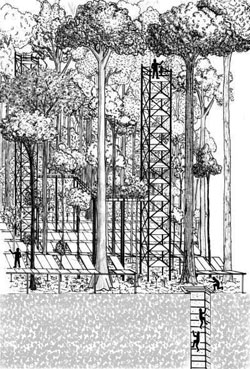 Three-dimensional sketch of the drought (rainfall-exclusion) experiment conducted by Nepstad and colleagues at the Woods Hole Research Institute and the Amazon Institute of Environmental Research (IPAM). By Kemel Kalif, IPAM |
So how does drought in the Amazon related to climate change? Subsequent studies, published after the now-controversial WWF report, have linked drought in the Amazon to warming sea temperatures in the tropical Atlantic. Previously it was thought that el Ni˜e was the primary driver of drought in the region, but the Amazon’s worst dry spell—which ran from 2005 through 2006—did not sync with el Ni˜o.
But Leake’s apparent dismissal of Nepstad’s data isn’t what may get him into trouble. Instead it’s his breach of the Editors’ Code of Practice which requires editors to allow “a fair opportunity for reply.” Andrew Rowell, the lead author of the WWF report who was criticized by Leake, was never contacted by the Sunday Times.
Still Leake has a point in criticizing the IPCC for citing a NGO report—generally a summary of existing research—rather than a peer-reviewed scientific paper.
“The IPCC could have picked a better citation than the WWF report, but the data were there, published in a few places to support their statement,” Nepstad told mongabay.com. “The latest attack on the IPCC is bizarre and unfounded.”
Leake did not respond the request for comment.
-
UPDATE
Amazongate fraud
(06/21/2010) The Sunday Times over the weekend retracted a column that accused the Intergovernmental Panel on Climate Change (IPCC) of making a “bogus rainforest claim” when it cited a report warning that up to 40 percent of the Amazon could be “drastically” affected by climate change. The “Amazongate” column, authored by Jonathan Leake, Science & Environment Editor of the Sunday Times, was immediately seized upon by climate skeptics as further evidence to discredit the IPCC just two weeks after it was found to be using shoddy glacier data in its 2007 climate assessment. But now the Sunday Times has removed Leake’s column from its web site and issued on apology, admitting that the Amazon claim was indeed supported by scientific research. The Sunday Times also acknowledged misconduct in the way one of the story’s sources—Simon Lewis of the University of Leeds in Britain—was quoted.
Related articles
Drought threatens the Amazon rainforest as a carbon sink

(03/05/2009) Drought in the Amazon is imperiling the rainforest ecosystem and global climate, reports new research published in Science. Analyzing the impact of the severe Amazon drought of 2005, a team of 68 researchers across 13 countries found evidence that rainfall-starved tropical forests lose massive amounts of carbon due to reduced plant growth and dying trees. The 2005 drought — triggered by warming in the tropical North Atlantic rather than el Niño — resulted in a net flux of 5 billion tons of carbon dioxide (CO2) into the atmosphere — more than the combined annual emissions of Japan and Europe — relative to normal years when the Amazon is a net sink for 2 billion tons of CO2.
Global warming may drive the Amazon rainforest toward seasonal forests rather than savanna
(02/11/2009) Changes in rainfall resulting from climate change may drive the parts of Amazon rainforest toward seasonal forests rather than savanna, argue researchers writing in the Proceedings of the National Academy of Sciences
Future threats to the Amazon rainforest
(07/31/2008) Between June 2000 and June 2008, more than 150,000 square kilometers of rainforest were cleared in the Brazilian Amazon. While deforestation rates have slowed since 2004, forest loss is expected to continue for the foreseeable future. This is a look at past, current and potential future drivers of deforestation in the Brazilian Amazon.
How accurate is long-term climatology data from the Amazon?
(03/03/2008) With some models forecasting significant change in the Amazon rainforest over the next century, it has been unclear whether the temperature and precipitation data upon which the projections are made is accurate. Now, new research by Rafael Rosolem of the University of Arizona, shows that data associated with the Large-scale Biosphere-Atmosphere Experiment in Amazon (LBA) — an international research initiative focusing on how changes in land use and climate will affect the biological, physical, and chemical functioning of Amazonia — is representative of normal climatology for the region. In other words, during most of the LBA data collection period, the data was not taken during severe drought or extreme wet periods.
Half the Amazon rainforest will be lost within 20 years
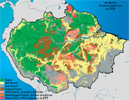
(02/27/2008) More than half the Amazon rainforest will be damaged or destroyed within 20 years if deforestation, forest fires, and climate trends continue apace, warns a study published in Philosophical Transactions of the Royal Society B. Reviewing recent trends in economic, ecological and climatic processes in Amazonia, Daniel Nepstad and colleagues forecast that 55 percent of Amazon forests will be “cleared, logged, damaged by drought, or burned” in the next 20 years. The damage will release 15-26 billion tons of carbon into the atmosphere, adding to a feedback cycle that will worsen both warming and forest degradation in the region. While the projections are bleak, the authors are hopeful that emerging trends could reduce the likelihood of a near-term die-back. These include the growing concern in commodity markets on the environmental performance of ranchers and farmers; greater investment in fire control mechanisms among owners of fire-sensitive investments; emergence of a carbon market for forest-based offsets; and the establishment of protected areas in regions where development is fast-expanding.
Small fires a big threat to Amazon rainforest biodiversity
(02/27/2008) Small fires have a big impact in the Amazon rainforest, report researchers writing in Philosophical Transactions of the Royal Society B. The findings suggest a dire future for Earth’s largest rainforest.
Greenhouse gas emissions have already caused the Amazon to dry
(02/27/2008) Anthropogenic emissions of greenhouse gases have already caused the Amazon to dry, finds a new study published in Philosophical Transactions of the Royal Society B.
Amazon rainfall linked to Atlantic Ocean temperature
(02/25/2008) Climate models increasingly forecast a dire future for the Amazon rainforest. These projections are partly based on recent research that has linked drought in the Amazon to sea surface temperatures in the tropical Atlantic. As the tropical Atlantic warms, the southern Amazon — the agricultural heartland of Brazil — may see higher temperatures and less rainfall.
Deforestation a greater threat to the Amazon than global warming
(02/25/2008) If past conditions are any indication of future conditions, the Amazon rainforest may survive considerable drying and warming caused by global warming, argue researchers in a paper published in Philosophical Transactions of the Royal Society B.
Large-scale Amazon deforestation or drying would have dire global consequences
(02/21/2008) A new study shows that large-scale degradation of the Amazon, either through drying or continued deforestation, would have global consequence, including worsening climate change, causing regional vegetation shifts, and increasing dust in the atmosphere.
Global warming – not el Nino – drove severe Amazon drought in 2005
(02/20/2008) One of the worst droughts on record in the Amazon was caused by high temperatures in the Atlantic rather than el Nino. The research, published in Philosophical Transactions of the Royal Society B, suggests that human-driven warming is already affecting the climate of Earth’s largest rainforest.
55% of the Amazon may be lost by 2030
(01/23/2008) Cattle ranching, industrial soy farming, and logging are three of the leading drivers of deforestation in the Brazilian Amazon. As commodity prices continue to rise, driven by surging demand for biofuels and grain for meat production, the economic incentives for developing the Amazon increase. Already the largest exporter of beef and the second largest producer of soy – with the largest expanse of “undeveloped” but arable land of any country – Brazil is well on its way to rivaling the U.S. as the world’s agricultural superpower. The trend towards turning the Amazon into a giant breadbasket seems unstoppable. Nevertheless the decision at the U.N. climate talks in Bali to include “Reducing Emissions From Deforestation and Degradation” (REDD) in future climate treaty negotiations may preempt this fate, says Dr. Daniel Nepstad, a scientist at the Woods Hole Research Institute.
Subtle threats could ruin the Amazon rainforest

(11/07/2007) While the mention of Amazon destruction usually conjures up images of vast stretches of felled and burned rainforest trees, cattle ranches, and vast soybean farms, some of the biggest threats to the Amazon rainforest are barely perceptible from above. Selective logging — which opens up the forest canopy and allows winds and sunlight to dry leaf litter on the forest floor — and 6-inch high “surface” fires are turning parts of the Amazon into a tinderbox, putting the world’s largest rainforest at risk of ever-more severe forest fires. At the same time, market-driven hunting is impoverishing some areas of seed dispersers and predators, making it more difficult for forests to recover. Climate change — an its forecast impacts on the Amazon basin — further looms large over the horizon.
2007 Amazon fires among worst ever
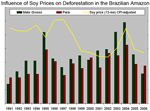
(10/22/2007) By some measures, forest fires in the Amazon are at near-record levels, according to analysis Brazilian satellite data by mongabay.com. A surge in soy and cattle prices may be contributing to an increase in deforestation since last year. Last year environmentalists and the Brazilian government heralded a sharp fall in deforestation rates, the third consecutive annual decline after a peak in 2004. Forest loss in the 2006-2007 season was the lowest since record-keeping began in the late in 1970s. While the government tried to claim credit for the drop, analysts at the time said that commodity prices were a more likely driver of slow down: both cattle and soy prices had declined significantly over the previous months.
Globalization could save the Amazon rainforest
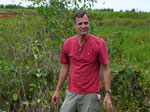
(06/03/2007) The Amazon basin is home to the world’s largest rainforest, an ecosystem that supports perhaps 30 percent of the world’s terrestrial species, stores vast amounts of carbon, and exerts considerable influence on global weather patterns and climate. Few would dispute that it is one of the planet’s most important landscapes. Despite its scale, the Amazon is also one of the fastest changing ecosystems, largely as a result of human activities, including deforestation, forest fires, and, increasingly, climate change. Few people understand these impacts better than Dr. Daniel Nepstad, one of the world’s foremost experts on the Amazon rainforest. Now head of the Woods Hole Research Center’s Amazon program in Belem, Brazil, Nepstad has spent more than 23 years in the Amazon, studying subjects ranging from forest fires and forest management policy to sustainable development. Nepstad says the Amazon is presently at a point unlike any he’s ever seen, one where there are unparalleled risks and opportunities. While he’s hopeful about some of the trends, he knows the Amazon faces difficult and immediate challenges.
Amazon rainforest locks up 11 years of CO2 emissions
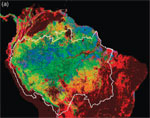
(05/08/2007) The amount and distribution of above ground biomass (or the amount of carbon contained in vegetation) in the Amazon basin is largely unknown, making it difficult to estimate how much carbon dioxide is produced through deforestation and how much is sequestered through forest regrowth. To address this uncertainty, a team of scientists from Caltech, the Woods Hole Institute, and INPE (Brazil’s space agency), have developed a new method to determine forest biomass using remote sensing and field plot measurements. The researchers say the work will help them better understand the role of Amazon rainforest in global climate change.
Amazon rainforest fires date back thousands of years
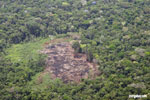
(03/14/2007) Fires are nothing new to the Amazon reports a study published in the journalBiotropica. Analyzing soils in the eastern Amazon, a team of scientists led by David S. Hammond of NWFS Consulting, has found evidence of forest fires dating back thousands of years. While the origin of these fires is unclear, the authors propose intriguing scenarios involving pre-Colombian human populations and ancient el Nino events which could have so dried rainforest areas that they became more prone to forest fires.
Global warming could cause catastrophic die-off of Amazon rainforest by 2080
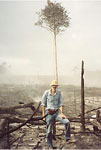
(10/23/2006) For the Amazon, there is an immense threat looming on the horizon: climate change could well cause most of the Amazon rainforest to disappear by the end of the century. Dr. Philip Fearnside, a Research Professor at the National Institute for Research in the Amazon in Manaus, Brazil and one of the most cited scientists on the subject of climate change, understands the threat well. Having spent more than 30 years in Brazil and now recognized as one of the world’s foremost experts on the Amazon rainforest, Fearnside is working to do nothing less than to save this remarkable ecosystem. Fearnside believes saving the Amazon will require a fundamental shift in perception where the Amazon is recognized as an asset beyond the current price of mahogany, soybeans, or cattle, where its value is only unlocked by its destruction. The Amazon is far worth more than this he says. It can play a key role in fighting climate change while providing economic sustenance for millions through sustainable agriculture and rational utilization of its renewable products. It can serve as a storehouse for biodiversity while at the same time ensuring reliable water supplies and moderating regional temperature and precipitation. In short, maintaining the Amazon as a viable ecosystem makes sense economically and ecologically — it is in our best interest to preserve this resource while we still can.
Rainforests face myriad of threats says leading Amazon scholar
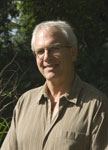
(10/17/2006) The world’s tropical rainforests are in trouble. Spurred by a global commodity boom and continuing poverty in some of the world’s poorest regions, deforestation rates have increased since the close of the 1990s. The usual threats to forests — agricultural conversion, wildlife poaching, uncontrolled logging, and road construction — could soon be rivaled, and even exceeded, by climate change and rising levels of carbon dioxide in the atmosphere. Understanding these threats is key to preserving forests and their ecological services for current and future generations. William F. Laurance, a distinguished scholar and president of the Association for Tropical Biology and conservation (ATBC) — the world’s largest scientific organization dedicated to the study and conservation of tropical ecosystems, is at the forefront of this effort.
40 percent of the Amazon could be grassland by 2050
(03/22/2006) Scientists today warned that 40 percent of the Amazon rainforest could be lost by 2050 due to agricultural expansion unless strict measures are taken to protect the world’s largest tropical forest.
Amazon drought continues, worst on record
(12/11/2005) The worst drought ever recorded in the Amazon continues according to an update from The New York Times. The drought has turned rivers into grassy mud flats, killed tens of millions of fish, stranded hundreds of communities, and brought disease and economic despair to the region.







